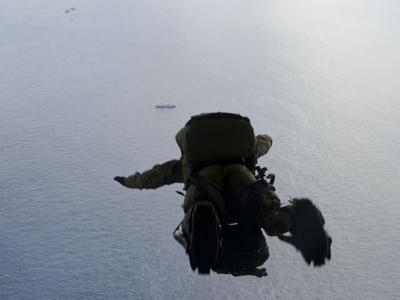Training Exercise Turns Into Real-World Scenario
Airmen from the 563rd Rescue Group responded to a rescue mission after being notified of a Venezuelan fishing boat 1,100 nautical miles off the Pacific coast of Mexico with two critically injured Chinese sailors May 02.

Airmen from the 563rd RQG were tasked to execute a real world mission involving the injured sailors while preparing for the combat search and rescue exercise, Angel Thunder.
According to rescue team reports, the Chinese vessel came under distress after a fire injured four sailors and left six missing. The remaining sailors boarded a life raft as their vessel sank and were later recovered by a Venezuelan fishing vessel. Seven of the Chinese fishermen were in good condition and were transferred with two of their fellow sailors who succumbed to their injuries, to a Chinese-flagged ship in the area, returning to China.
Airmen from the 563rd Rescue Group flew in a 79th RQS HC-130J Combat King II for nearly 11 hours, to parachute guardian angel teams near the ship. They used two inflatable zodiac boat packages and medical equipment to board the vessel and stabilize the injured sailors. "We were preparing for the training exercise when we were notified of what was going on,” said 1st Lt. Ben Schmidt, 48th Rescue Squadron combat rescue officer. “As a guardian angel, this is what we are trained and equipped to do, so there is no better way to show our capabilities.
Schmidt explained that upon landing in the water, the rescue team ensured each member who jumped was okay, then checked for accountability of their gear. “They then proceeded to the ship... to assess and treat their patients. Once they were stabilized... they continued medical treatment of the injured Chinese sailors." Schmidt added that the team will prepare to transport the injured to Cabo San Lucas, Mexico, where they will be loaded onto a 79th RQS HC-130J Combat King II aircraft and flown to the La Jolla Burn Facility in California."
According to a rescue group commander, Guardian Angel is the Air Force's human-centric and equipment-based weapon system that executes all five tasks of personnel recovery: report, locate, support, recover and reintegrate. Guardian Angel teams consist of combat rescue officers, pararescuemen, or PJs, and survival, evasion, resistance, and escape specialists. "We are prepared to rescue anyone, anytime, anywhere, when tasked by the Air Force," said Col. Sean Choquette, the 563rd RQG Commander. "Our Airmen train diligently to execute difficult missions like this one.

"We have three factors that are in our favor, for this particular mission: the 563rd RQG was ready for exercise Angel Thunder, which trains rescue personnel for situations very similar to this mission,” Choquette said. “The 79th RQS has the HC-130J Combat King IIs, the newest C-130 models in the Air Force, which are capable of aerial refueling, enabling them to travel farther and deliver lifesaving care faster. Finally, the 161st Air Refueling Wing was already part of the Angel Thunder team, and with a telephone call from the exercise director, Brett Hartnett, immediately supported our need for refueling over the Pacific Ocean,"
Guardian Angel is considered the ground component within the Air Force rescue triad. As such, combat rescue officers and pararescuemen deploy as teams into uncertain or hostile environments. They are trained to operate independently or in conjunction with rotary- and fixed-wing aircraft, watercraft and overland vehicles, in order to locate, authenticate, and recover isolated personnel for return to friendly control.
"Water rescues are highly complex and the distance, which required multiple aerial refueling operations, present more challenges in this rescue," said Maj. Scott Rein, a 563rd RQG operations center planner. "Everyone has complicated tasks in this mission; from the Guardian Angels treating injured sailors with equipment they had to parachute in with, to aviators who are flying very long missions and support personnel who are executing their roles at a remote airfield in Mexico. Everyone is rising to the occasion."
ANN Salutes Staff Sgt. Adam Grant, Angel Thunder Public Affairs
(USAF Images)
 ANN's Daily Aero-Term (04.28.24): Airport Marking Aids
ANN's Daily Aero-Term (04.28.24): Airport Marking Aids Aero-News: Quote of the Day (04.28.24)
Aero-News: Quote of the Day (04.28.24) ANN's Daily Aero-Linx (04.28.24)
ANN's Daily Aero-Linx (04.28.24) Aero-News: Quote of the Day (04.29.24)
Aero-News: Quote of the Day (04.29.24) ANN's Daily Aero-Linx (04.29.24)
ANN's Daily Aero-Linx (04.29.24)




